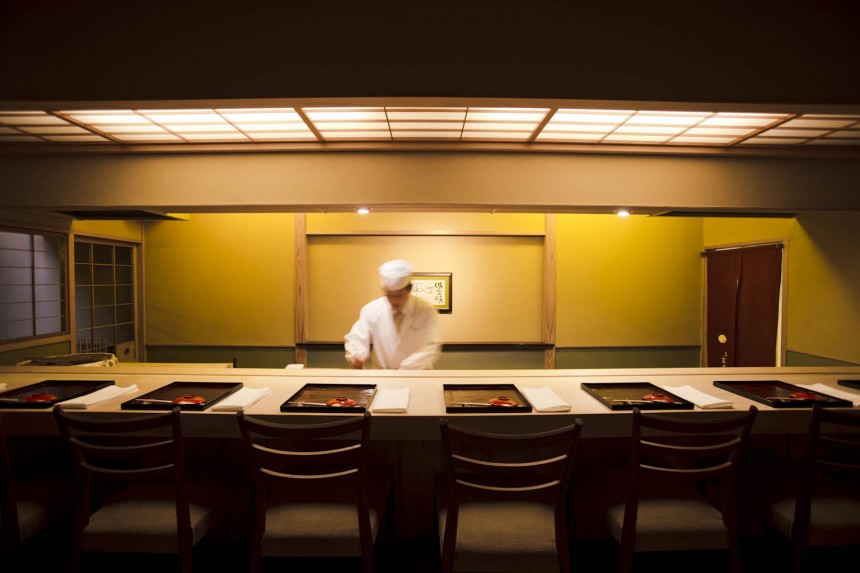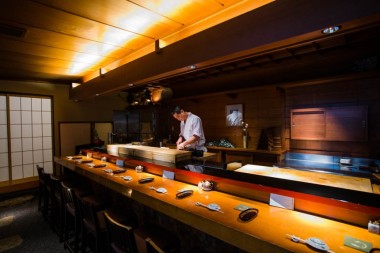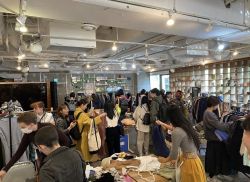
May 29, 2018
Door to Dining
Japanese food is in demand, but are businesses able to cater to tourists and non-Japanese speakers?
Derya Ozyuvali – otherwise known as Foodie Backpacker – travels for his living. He is hired by people around the world to cook dinner parties at their homes, and uses the proceeds to pay for even more travel. Yet, when I met him one Friday evening in Shinjuku, he immediately appealed for my help. Opening a notebook to reveal pages of meticulous notes, he turned to me with a serious expression. “I need you to book some restaurants for me.” If a professional foodie traveller – someone who’s prepared to dedicate hours to working out where and what he wants to eat – needs help, there might be a bit of a problem.
Japan is welcoming a record number of visitors – 28.7 million tourists arrived in 2017, up from 10.4 million in 2013. Ahead of the 2020 Tokyo Olympics, the debate over how to harness these numbers is reaching fever pitch. And with Japanese food growing in popularity abroad, feasting on the good stuff tops many visitors’ lists. For gourmet adventurers, simply wandering into the nearest restaurant isn’t going to cut the mustard. Equally, many are keen to understand the cuisine and its relationship with culture.
Cooking schools across the capital are mushrooming, offering all kinds of lessons from creative sushi making to beautiful seasonal sweets. When Ayuko Akiyama founded Buddha Bellies Cooking School in 2011, there were only a few other companies. But now, she says, there are around 100 in the market. Guests are making more detailed requests, too. By popular demand, she now offers ramen classes where students can make noodles from scratch.
Another new service is Tadaku with Locals, chosen as part of the Tokyo Metro Accelerator Program 2016. It offers cooking or dining sessions in Japanese homes, and is wise to worldwide diets – halal, vegan and other menus are all available. While options are increasing across Tokyo, finding a restaurant that serves Japanese food and caters to dietary requirements can be difficult. Tadaku also tackles the mysterious Japanese supermarkets, which can be a challenge even with language ability. Not sure what to do with that grey, gelatinous substance known as konnyaku? Take a shopping trip with your host – Tadaku says almost half their guests choose to do so.

Yet, while we may all love to pretend we’re culinary masters, dining out is an essential part of experiencing Japan. Especially for visitors with limited time, they’re going to want to make sure every mouthful counts. Spying a gap in the market is TableAll, which has opened up access to high-end restaurants across the country. It operates on a unique business model for restaurants in Tokyo: it buys up seats in advance to subsequently sell to clients, thus guaranteeing payment for the restaurants.
The company is the brainchild of Takashi Yamada, who spent 15 years at Goldman Sachs. Not only was he making reservations for overseas friends, but when entertaining clients, many high-end establishments regularly told him they would love to see more diverse clientele. “I think people are wrong about (the restaurants) not being welcoming,” he says. “In fact, some told me they actually prefer overseas visitors, as they are more likely to get direct feedback, to be told directly that it’s delicious.”
This cemented the idea for TableAll. Yamada launched the service in September 2016 and now has around 80 restaurants on board. Of course, there are caveats – namely, the restaurants are strict on the kind of customers they welcome. Guests must be polite, well-dressed, punctual and so on. Yamada spent a lot of time curating the image of his site, as well as communicating the rules. Reputation, as they say, takes a long time to build, but can be lost in an instant.

Even the wealthy, luxury-seekers among us still need a taste of the everyday – and the amazing thing about dining in Japan is you don’t need to splash out. Yet information remains frustratingly opaque. One of the leading online restaurant resources for Japanese speakers, Tabelog, launched a multi-language version back in 2015, but with such limited functionality, it’s about as useful as trying to cut steak with a plastic knife – even if it were top grade Kobe beef.
No online resources seem to have captured the market when it comes to catering for non-Japanese speakers, but many are trying. One of the earliest into the game was Gurunavi, a website and app that allows users to search for restaurant by location and cuisine type, alongside other conditions such as non-smoking. Following a revamp in 2015, restaurants can enter details about their menu, including the cooking style, ingredients and portion size, which is then automatically translated into four languages – meaning that information is more easily kept up-to-date.
The website isn’t exactly beautiful and options remain limited. But the company is proactively striving to expand into the market – a partnership with TripAdvisor allows hungry researchers to click through to Gurunavi’s online reservation concierge service for some venues, and subsequent tie-ups with Chinese and Taiwanese online travel agencies has led to them offering pre-payment bookings.
The problem is that many restaurants are simply not online. Ozyuvali found obtaining Tokyo restaurants’ contact email addresses nearly impossible. And as he points out, who is going to spend a fortune on an overseas phone call, especially when there’s no guarantee you’ll understand each other?
On the restaurant side, communication is definitely an issue on the table. Hidenao Kuboki, who has ten years’ experience of managing stores, launched Tsukune Samurai Sakanoue in Shibuya in December last year. Here, customers can enjoy chicken meatballs while admiring fearsome samurai performances. The website and menu are available in English, but the staff don’t undergo any specific language training. “I believe customers are a mirror reflecting yourself,” he says. “If you are afraid, customers will also be afraid. If you are happy, they will also be happy. The important thing is not the language or skills but the atmosphere you create.”
That is a sentiment that Ai Uchida, founder of hospitality English service Tokyo A La Carte, would support: “I don’t really teach English – I teach confidence.” Few visitors, she adds, are looking for a completely sleek experience. Mystery and “foreignness” are part of the appeal.
But given the internet is a go-to resource, the lack of online information means a lot of food remains off the map – and therefore off the plate. This is also a struggle for those working to promote inbound tourism, as further afield destinations often rely on printed flyers, and often only available in Japanese. There’s a push to digitize and some of these efforts may filter over to food. Moreover, just like Tadaku with Locals benefited from a business accelerator program, money is being poured into innovation initiatives, so the door to dining may open wider. After all, people are always hungry for food, and businesses are always hungry for customers.





